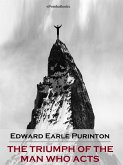In most people's minds, the term Personal Magnetism conveys the idea of a current radiating from the person of the magnetic individual, drawing to itself all those within the radius of its magnetic force. This idea, although erroneous on the whole, nevertheless contains within it the germ of real truth. There is a current of attractive force radiating from man, but it is not a magnetic force to the extent that the term "magnetism" implies any connection with magnet or electricity. The human magnetic current, while having some resemblance to these two familiar forces in its effects, has no real connection with them as far as its origin or intrinsic nature is concerned.
What we call Personal Magnetism is the subtle current of thought-waves, or thought-vibrations, projected by the human mind. Every thought created by our mind is a force of greater or lesser intensity, varying in strength according to the impulse given to it at the time of its creation. When we think, we send out from us a subtle current, flowing like a thick ray away from us through space, a strong thought will go on a mission charged with a powerful power, and will often break down the instinctive resistance of the minds of others to external impressions, while a weak thought will not be able to gain a Trance entrance to the mental castle of another, unless that castle is poorly guarded. Repeated thoughts along the same lines, sent one after another, often produce an entrance where a single wave of thought, though much stronger, will be repelled. It is a display of a physical law in the psychic world, and exemplifies the old saying about the constant drip that consumes a stone.
We are all influenced far more than we are aware by the thoughts of others. I don't mean by their opinions, but by their thoughts. A great writer on this subject says very sincerely, "Thoughts are things." They are things, and very powerful. If we do not understand this fact, we are at the mercy of a powerful force whose nature we do not know and whose existence many of us deny. On the other hand, if we understand the nature and laws that govern this wonderful force, we can master it and make it our instrument and assistant. Every thought we create, whether weak or strong, good or bad, healthy or unhealthy, sends out its vibratory waves, which affect, to a greater or lesser degree, all those with whom we come in contact, or who may come within the range of our thought vibrations. Thought waves are like ripples on a pond caused by the throwing of a stone; they move in ever-widening circles, radiating from a central point. Naturally, if an impulse projects thought waves strongly toward a certain object, its force will be felt most strongly at that point.
The man who thinks about Energy manifests Energy. The man who thinks about Courage manifests Courage. The man who thinks, "I can and will," "comes," while the man who "cannot" "remains." You know that this is true. Now, what causes the difference?
What we call Personal Magnetism is the subtle current of thought-waves, or thought-vibrations, projected by the human mind. Every thought created by our mind is a force of greater or lesser intensity, varying in strength according to the impulse given to it at the time of its creation. When we think, we send out from us a subtle current, flowing like a thick ray away from us through space, a strong thought will go on a mission charged with a powerful power, and will often break down the instinctive resistance of the minds of others to external impressions, while a weak thought will not be able to gain a Trance entrance to the mental castle of another, unless that castle is poorly guarded. Repeated thoughts along the same lines, sent one after another, often produce an entrance where a single wave of thought, though much stronger, will be repelled. It is a display of a physical law in the psychic world, and exemplifies the old saying about the constant drip that consumes a stone.
We are all influenced far more than we are aware by the thoughts of others. I don't mean by their opinions, but by their thoughts. A great writer on this subject says very sincerely, "Thoughts are things." They are things, and very powerful. If we do not understand this fact, we are at the mercy of a powerful force whose nature we do not know and whose existence many of us deny. On the other hand, if we understand the nature and laws that govern this wonderful force, we can master it and make it our instrument and assistant. Every thought we create, whether weak or strong, good or bad, healthy or unhealthy, sends out its vibratory waves, which affect, to a greater or lesser degree, all those with whom we come in contact, or who may come within the range of our thought vibrations. Thought waves are like ripples on a pond caused by the throwing of a stone; they move in ever-widening circles, radiating from a central point. Naturally, if an impulse projects thought waves strongly toward a certain object, its force will be felt most strongly at that point.
The man who thinks about Energy manifests Energy. The man who thinks about Courage manifests Courage. The man who thinks, "I can and will," "comes," while the man who "cannot" "remains." You know that this is true. Now, what causes the difference?









